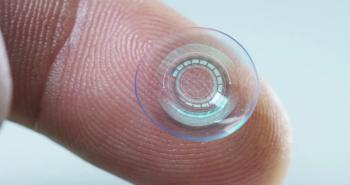
This week in optometry: April 24-April 28
Catch up on what happened in optometry during the week of April 24-April 28.
Catch up with what Optometry Times®' shared this week:
Optometry news
Inaugural IKA Keratoconus Symposium 2023
The brightest minds in keratoconus came together in Scottsdale, AZ, to educate clinicians on the latest in diagnosis, treatment, and care of patients. Attendees were bubbling with excitement as they discussed new techniques and poignant pearls.
ARVO 2023 coverage
The Ophthalmology Times® team was in full force at The Association for Research in Vision and Ophthalmology (ARVO) 2023 Annual Meeting April 23 - 27 in New Orleans, Louisiana.
Highlighted coverage for Optometry Times®:
Amniotic membranes: Clinical use for anterior segment disease
Ashley Wallace-Tucker, OD, FAAO, FSLS, Dipl ABO
Although the use of amniotic membranes (AMs) in eye care is relatively novel, the use of human placental tissue in medicine has been around for well over a century. In the early 1900s, human placental membranes were successfully utilized as a skin substitute. As technology and screening methods advanced, use of human placental membranes expanded across many medical disciplines including dentistry, podiatry, gynecology, plastics, urology, and orthopedics.1
The first documented use of human placental membranes in eye care was in 1940 when de Rotth reported success using an AM for the treatment of an ocular burn wound.2 Although the treatment was successful, the use of AMs then went out of favor until the early 1990s when improved processing and storage techniques were developed.
Apellis partnering with actor Henry Winkler to bring happy days to fight against geographic atrophy
David Hutton, Managing Editor, Ophthalmology Times
Apellis Pharmaceuticals Inc. announced a new campaign with actor Henry Winkler to raise awareness of
The GA Won’t Wait campaign helps older adults and their families understand and recognize the symptoms of this progressive and irreversible disease. Together, Apellis and Winkler are empowering people over the age of 60 to monitor and discuss vision changes with an eye doctor, such as a retina specialist, ophthalmologist, or optometrist.
The complicated ins and outs of pediatric glaucoma
Samantha Rosen, OD
As a new parent, I now understand why parents constantly worry about their children. Will they be happy and healthy? Will they have any developmental delays? What if they fall and hurt themselves? What if they are bullied? The possibilities are endless, but as an eye care provider I also worry about conditions that could cause vision loss.
Pediatric glaucoma is one of these conditions that, although rare, can cause irreversible vision loss and leave children visually impaired if not treated timely and adequately. Primary congenital glaucoma accounts for 50% to 70% of all pediatric glaucoma, and its prevalence is approximately 1 in 10,000 births.1 Other types of pediatric glaucoma can be acquired (eg, through trauma, intraocular surgery) or secondary to a systemic condition, such as Sturge-Weber syndrome, or ocular anomaly, such as aniridia.
FDA approves CT LUCIA 621P Monofocal IOL from Zeiss
Emily Kaiser, Assistant Managing Editor; Kassi Jackson, Editor
Zeiss announced the US Food and Drug Administration (FDA) approval of CT LUCIA 621P Monofocal IOL.1 This aspheric, monofocal, single-piece C-loop IOL features optic (ZO) asphericity concept technology from Zeiss, which is designed to compensate for a wide range of spherical aberrations while optimizing visual outcomes in the event of potential decentration and lens misalignments.
Behind the creation of the 20-20-20 rule for digital eye strain
Jeffrey Anshel, OD, FAAO
Unless you’ve been practicing under a rock for the past 15 years, you’ve likely heard of the “20- 20-20 rule" for computer eye strain. It has been recommended by almost every major state association and eyecare industry outlet, including the American Optometric Association (AOA), the American Academy of Ophthalmology (AAOpt), The Vision Council and many more. But have you ever wondered where it came from or what was the rationale for the practice?
New and emerging myopia management: Repeated low-level red-light therapy
Ashley Wallace-Tucker, OD, FAAO, FSLS, Dipl ABO
In my last blog, we discussed the specifics of outdoor time as a tool to prevent or slow the onset of myopia. The most widely accepted recommendation is at least 2 hours per day of outdoor time participating in any activity that engages the child’s distance vision. Furthermore, a recent systematic review and meta-analysis revealed that increasing a child’s outdoor time by an additional 76 minutes per day reduces their risk of incident myopia by 50%.1
Although this finding is remarkable, many parents may argue that spending over 3 hours per day outdoors is a near impossible feat for their child. Some of the challenges with lengthy outdoor time include variations in climate, proper supervision, accessibility to adequate outdoor space, and seasonal allergies.
However, imagine an indoor therapy that could simulate outdoor time and potentially provide the same positive impact on myopia.
Community care: Connecting mentorship and representation
Jill Saxon, OD; Emily Kaiser, Assistant Managing Editor
Jill Saxon, OD, returns to Optometry Times On Air to discuss industry achievements, including the launch of the Women's Leadership Network and the Military Network at Bausch + Lomb.
Basic and beyond: technology for every level of scleral lens management
Maria K. Walker, OD, PhD
Ten years ago, I was midway through a cornea and contact lens residency at Pacific University and wondering whether scleral lenses (SLs) would be here to stay or if they were a passing trend. In 2023, it seems SLs are being reached for more than ever. Along with the continued excitement about using SLs, we have seen impressive advancements in the technology to fit and manage them.
During my evolution as a scleral practitioner, I have encountered a range of approaches to fitting, using equipment as ubiquitous a slit lamp as well as some of the most advanced fitting technology in the world. Most recently, I took the plunge to add 1 advanced tool that was missing from my toolbox, the EyePrintPro (EyePrint Prosthetics). This custom, 3D-printed, impression-based lens is among the most sophisticated tools available for fitting SLs. But I didn’t reach for this technology right out the gate; I grew into it and my patient base evolved to include patients who need advanced levels of SL wear. My experience with SL technology has helped me understand how different technologies can be used at different levels of SL management.
Practical management EP 14: Your practice-purchase checklist
Maria Sampalis, OD; Kassi Jackson, Editor
Hear from Maria Sampalis, OD, on what to have on your checklist when purchasing a practice.
Pediatric glaucoma after cataract surgery
Lynda Charters
Glaucoma specialists nationwide reported that
The researchers wanted to determine the cumulative incidence of glaucoma-related adverse events, ie, defined as glaucoma or glaucoma suspect, and factors associated with their risk during the first 5 years after lensectomy before children reach the age of 13 years.
Newsletter
Want more insights like this? Subscribe to Optometry Times and get clinical pearls and practice tips delivered straight to your inbox.















































